Think 9-to-5 isn’t your thing? Welcome to the party. Many students and grads crave more freedom, and freelancing offers just that.
As a freelancer, you choose your clients, rates, and schedule. No micromanaging boss, no dependencies on your colleagues, just you — calling the shots.
It’s especially appealing because you gain real-world experience on your terms. You can start small with a few projects alongside your studies and scale up (or not) over time. It’s a smart way to earn while you learn, and it builds a portfolio that makes you shine post-grad.
But freelancing isn’t that simple and it’s definitely not for everyone. It comes with hurdles — erratic paychecks, tedious admin work, and client-wrangling stress.
Dive into this guide to see if freelancing is your next adventure (and if it is, learn how to do it right).
We’ll cover:
- The honest pros and cons of freelancing, so you can make an informed decision
- Essential questions to ask yourself before diving in
- Practical, step-by-step guidance on how to set up your business
- Insider tips for reaching out to your first clients and landing those initial projects
By the end, you won’t just know if freelancing is right for you — you’ll be equipped with everything you need to start building your own business, make money, and set yourself up for success.
Basic Things to Know About Freelancing
Picture this — you wake up at 10 AM, brew a pot of coffee, and settle into your favorite comfy chair with your laptop.
No soul-crushing commute, no stuffy offices, no supervisors. That’s the allure of freelancing — you’re the CEO of your own career, you choose your projects, you decide on your hours, and work from wherever you like.
Sounds like a dream, right?
But now picture this — juggling five deadlines at once, no steady paycheck, and the constant pressure of finding new clients. You can go on a month-long vacation, sure — but that might mean living paycheck to paycheck when work slows down.
Both of these scenarios are possible, and which one becomes your reality depends entirely on how you manage your freelancing journey. There will be highs and lows, and every decision you make can swing the outcome either way.
What types of work can you do as a freelancer?
Freelancing is a form of self-employment where you offer your skills and services to multiple clients on a project-by-project basis, rather than being tied to a single employer. They can choose when and where to work, but they don’t get the same benefits as regular employees, like health insurance or a guaranteed paycheck.
Here are the most common types of freelance careers:
- Writing & editing — Write content or polish manuscripts. Ideal if you’re word-savvy.
- Graphic design — Create visuals like logos and social media graphics that bring brands alive.
- Programming & web development — If you have a knack for coding, you can build websites, create mobile apps, and develop software solutions.
- Tutoring & online teaching — Help students hit academic or language learning goals.
- Social media management — Work with individuals and companies to create engaging content, build communities, and analyze data to grow brands.
- Virtual assistant — Work with C-level execs to handle administrative tasks, manage emails, schedule appointments, and keep things organized.
Four reasons to consider freelancing as a student or new grad
Unlike traditional jobs, freelancing gigs offer some unique perks, like:
- Flexibility — Work from anywhere, anytime. All you need is a stable internet connection.
- Autonomy — You choose the projects and clients you want to work with, which means you don’t have to put up with projects and tasks you don’t like or deal with toxic managers.
- Earning potential — Set your rates and potentially earn more than in a traditional job. As your experience and reputation grow, raise your fees. Satisfied clients lead to referrals, helping you work less while earning more.
- Skill development — Freelancing is a fantastic way to gain experience across different projects and industries. You’ll constantly be learning new skills and expanding your knowledge base.
The flipside of freelancing
Let’s be realistic for a second. Freelancing comes with a couple of downsides to consider if you want to have a balanced outlook.
- Income instability — Freelancing income can be unpredictable. Some months you might have a steady stream of projects, others might be slower.
- No benefits — 9–5 jobs might be boring, but they compensate with upsides like health insurance, paid time off, and a retirement plan. As a freelancer, you’ll have to figure out all these benefits on your own. (I’ll cover this in more depth later.)
- Self-discipline is a must — You need to manage your time effectively and avoid distractions, which can be difficult when a comfy couch and Netflix are a few steps away. Nobody’s watching, so you can work from your PJs at 2 a.m., and this kind of lifestyle can seriously blur the line between your job and personal life, ultimately making it impossible for you to unplug and recharge.
- Client acquisition — Finding and securing clients can be a challenge, especially when starting out. Apart from doing your actual work, you’ll need to be a one-person marketing team for yourself — which can be exhausting and stressful.
Are You Cut Out for Freelancing: The Assessment
Freelancing is a great opportunity for students and new grads, but you need to have a certain set of skills to be successful.
5 key traits of successful freelancers
- Self-discipline — Can you stay motivated and resist distractions, even when you’re working solo and tempted by nonwork tasks?
- Time management — Are you skilled at juggling multiple projects, organizing your time, and meeting deadlines?
- Resilience — How well do you handle setbacks like client disagreements, negative feedback, or dry spells? Can you bounce back quickly with a positive attitude?
- Communication — Do you know how to communicate clearly, listen actively, explain complex ideas simply, and handle feedback with ease?
- Problem-solving — Can you adapt quickly and come up with solutions when things don’t go as planned?
So, is freelancing for you?
If you’re unsure if freelancing is the right career for you, check the following questions and find out.
Why do you want to become a freelancer?
Try to figure out why you’re drawn to freelancing. Is it because of the flexibility factor and the prospect of working from your sofa with your favorite playlist on repeat in the background? Or maybe because you want to take a gap year and travel around Europe?
If you’re chasing quick money or think freelancing is less demanding than a regular job, you’re doing it for the wrong reasons. Yes, there’s a lot of flexibility and freedom, but you still need to meet deadlines (and even do longer hours occasionally).
Are you comfortable with some uncertainty?
If the thought of not having a regular paycheck makes you uncomfortable, then freelancing isn’t for you. On the other hand, if you can roll with the punches and don’t mind the unpredictability, then absolutely go for it.
Do you have skills or talents that others would find valuable?
There are people who have turned their passions and hobbies into lucrative freelance careers. However, you should be realistic and aim for something you’re good enough at to launch a successful freelance career, rather than chase after making your pet project come true. For example, you don’t have to dream about becoming a Pulitzer-winning novelist to be a successful content writer or copywriter (speaking from experience here). But you do need to be better-than-average with words (also from experience).
Striking the right balance means identifying your strengths and finding clients who need those specific skills. It’s all about matching your talents to market demand. You can always weave in your passions and interests later on.
Take our Career Quiz to learn if freelancing is right for you:

Setting Up Your Freelance Business
Once you decide to start a freelancing career, you need to lay a solid foundation for your business.
This means taking care of some essential legal and logistical stuff.
Legal stuff: Dotting your I’s and crossing your T’s
The exact legal requirements can vary depending on where you live, but below, you can find a quick guide to help you get your freelance business up and running.
You have a few options when it comes to registering your freelance business, but these two are the most common.
- Sole proprietorship —This is the simplest and most common structure for freelancers. You and your business are considered one entity, which means you’re personally liable for any business debts or obligations. The good news is that there’s usually minimal paperwork involved.
- Partnership — If you’re teaming up with another freelancer, a partnership might be the way to go. It allows you to pool resources and share responsibilities, but like a sole proprietorship, you’re personally liable for business debts.
The best structure for your freelance business will depend on factors like your income level, risk tolerance, and long-term goals. It’s a good idea to do some research or consult with a legal or financial professional to determine the best fit for your specific situation.
The next thing to think about is the taxes, but I’ll get back to that a bit later.
Choosing a freelance niche
There are 1.57 billion freelancers around the world, and only in the U.S. that number is around 76.4 million, so it’s safe to say you’re up against a lot of competitors.
The solution to this crowded market challenge is niching down your services.
But what’s a niche, anyway?
In the freelance lingo, a niche is like your specialty or your area of expertise. It’s what sets you apart from all the others and makes you the go-to person for a specific type of service. Think “freelance writer specializing in blockchain” or “graphic designer for health and wellness brands.”
Niching down might seem limiting at first as it will inevitably bring you fewer clients, but it’s a secret ingredient for freelance success as it allows you to:
- Become an expert — Focusing on a specific area lets you become a true pro, which means delivering higher-quality work (and charging higher rates).
- Attract your ideal clients — When you have a niche, you attract clients who are specifically looking for what you offer. This means less time chasing after random gigs and more time working on projects you love.
Here’s how you can find your niche:
- Do self-assessment — Jot down your skills, interests, and experiences. What are you good at? What do you enjoy doing? What kind of work makes you feel energized and excited?
- Conduct market research — Use Google Trends, browse freelance platforms, and check out industry blogs to see what’s in demand.
- Use AI/GPT Tools for niche exploration — If you need some extra help brainstorming, AI tools can be exactly what you need. Try prompts like:
- “List potential freelance niches for someone with skills in [your skills]”
- “Analyze the market demand for freelance services in [potential niche]”
- “What are the most profitable freelance niches in [your industry]?”
- Experimentation — Don’t be afraid to test the waters. Try taking on a few small projects in different niches to see what feels right. The results might shock you.
Remember that finding your niche might take some time and trial and error, but it can be rewarding.
Creating a productive workspace (even in a tiny apartment)
You may not have a fancy corner office with a skyline view, but that doesn’t mean you can’t create a workspace that inspires productivity and creativity. No matter where you’re working from — your dorm room, a kitchen table, or a cozy nook in your apartment, here’s how you can make the most of your space:
Choose a dedicated work zone
When you don’t work from an office, it’s very easy to fall into the trap of procrastination and not taking your tasks seriously.
So, even if it’s just a corner of a room, having a designated workspace helps you mentally shift into “work mode” and minimize distractions. This signals to your brain (and anyone else sharing your space) that when you’re in that zone, you mean business.
Declutter your space
To minimize distractions and maximize focus, keep your workspace tidy and organized. Head to Target for some stylish storage solutions (shelves, drawers, boxes) to keep things neat and tidy.
Light it up
Good lighting is essential for productivity and can boost your mood. If possible, set up your workspace near a window to take advantage of natural light. Otherwise, look for a good desk lamp.
Think about ergonomics
Don’t underestimate the importance of a comfortable and ergonomic setup. This might sound like a boomer problem, but these issues can sneak up on you even in your 20s if you’re not careful.
(This is just my herniated disk sharing some hindsight wisdom.)
So, don’t skimp on a supportive, ergonomic chair, make sure to adjust your monitor to the correct height, and use a keyboard and mouse that promote good posture. Your future self will thank you.
Tech up your workspace
Make sure you have the right tools for the job. Your computer needs to be reliable, and so does your internet connection. You may also need to consider costs like website hosting, plus software or apps that are essential for your work.
Pro Tip: If you plan to travel while freelancing, make sure you invest in a good VPN. Fun fact: You can’t access the internet in China from a computer bought outside of China without VPN
Embrace flexibility
Don’t be afraid to switch things up and try working from different locations, like a coffee shop, a co-working space, or the local library. A change of scenery can really make a difference.
Building a Killer Portfolio and Online Presence
You’ve got the skills, the motivation, and the legal stuff sorted. Now it’s time to show the world what you’re made of.
Building a strong portfolio and online presence is like creating a storefront for your freelance business. It’s how you attract clients, showcase your talents, and build credibility in your field.
Choose samples of your work you want to showcase
Think of your portfolio as your greatest hits album — a curated collection of your best work that highlights your skills and experience.
Here’s how to decide on the general direction of your portfolio:
- Choose the right platform — There are tons of online platforms where you can showcase your work. For visual creatives, platforms like Behance and Dribble are popular choices. If you’re a writer, get yourself a Muck Rack and HARO profile, and consider creating a website with a dedicated portfolio section. Platforms like Clippings.me can come in handy too.
- Quality over quantity — Don’t just throw everything you’ve ever created into your portfolio. Choose your best and most relevant pieces that demonstrate your skills and align with your target niche.
- Tell a story — Each project in your portfolio should tell a story about your process, your skills, and the results you achieved. Include brief descriptions that illustrate the challenges, your approach, and the outcome.
- Keep it updated — As you complete new projects, add them to your portfolio to keep it fresh and relevant. Remove any outdated or less impressive pieces to ensure you’re always showcasing your best work.
Create a website
Your website is the place where potential clients can learn about you, browse your work, and easily get in touch. It’s a crucial part of building your freelance brand and establishing credibility.
Luckily, you can do this even if you’re not particularly tech-savvy.
First, you should choose a domain name, that is, your website’s address (like www.yourname.com). Make it memorable, easy to spell, and relevant to your freelance services.
Unless you’re a coding whiz, using a website builder is the easiest way to create a professional-looking site. Popular options include Wix, Squarespace, Framer, and WordPress.com. They offer user-friendly interfaces, customizable templates, and all the tools you need to get started.
Most website builders offer a variety of templates to pick from. Select one that aligns with your brand aesthetic and the type of services you offer.
Every freelance website needs these pages:
- Homepage — This page is essential for making a great first impression. Keep it concise and engaging, and clearly communicate what you offer.
- About page — Share your story, your experience, and what makes you unique. Let your personality shine through.
- Portfolio page — Showcase your best work with high-quality images and concise descriptions.
- Contact page — Make it easy for potential clients to reach you. Include your email address, social media links, and a contact form.
Promote yourself on social media
When choosing social media to build profiles on, focus on those that suit your offerings and where your ideal clients hang out (not where you hang out).
Here are a few popular choices for freelancers:
A must for freelancers. To make the most of it, create a polished profile that reflects your experience and expertise. Then, start creating educational and insightful posts, as this is a great way of establishing yourself as an authority in your niche.
Another way to expand your network and catch the eye of potential clients is by joining relevant groups and participating in discussions. Don’t simply send connection requests to people only to remain silent — interact with your connections, comment on their posts, respond to their questions, and try to add value with your comments.
A couple of successful freelancers to check out: Masooma, Jay, and Karina.
Reddit can feel like a maze, but it can be a great resource for tips on freelancing and potentially finding clients if you know how to navigate it.
Instead of just jumping in with self-promotion, try a reverse-engineering approach. Explain your situation and ask a genuine question about how to promote your services and build your freelancing portfolio. It’s also a good idea to engage in discussions where you can showcase your expertise, as this will help you get noticed.
X and Threads
These two platforms are great for connecting with talent and engaging in industry conversations.
If you’re a new freelancer, being on X is a smart move for several reasons. First, you can follow and engage with industry thought leaders in real-time. You basically get a front-row seat to expert advice, trends, and insider tips. Second, being actively engaged through posts and retweets can help you build credibility and expand your own network.
For inspo, here’s a list of 40+ freelancers to follow on X.
Instagram works best for creative or visual fields where the visual aspect of the product matters, but other freelancers can benefit too.
Some jobs where Instagram can make a difference with promoting your business: photographer, videographer, graphic designer, illustrator, fashion designer, stylist, make-up artist, beauty professional, architect, interior designer, skincare.
There are also Instagram accounts that you can use to grow your freelance career. Some good places to start are Jamie • Business of Freelance or Freelancing Females.
GitHub
GitHub is crucial for freelancers (but only if you’re in tech, design, and development), because it serves as a public portfolio where you can showcase your coding skills and completed projects. You can use it to collaborate with clients and other freelancers by managing version control and tracking project changes in real time. And, let’s be real — having an active GitHub profile will show you have the technical expertise, and this will give you a competitive edge.
Pro tip: To make social media work for you as a freelancer, you need to be consistent. You need to show up regularly and follow algorithm best practices (post at optimal times, use hashtags, interact with your followers, and experiment with different types of content). Building a following, establishing trust, and converting that audience into paying customers doesn’t happen overnight — it requires a continuous presence, a strategy, and patience (6–12 months at least).
Finding Your First Freelance Gig: Platforms, Networking, and Pitches
When you’re starting out as a freelancer, it’s difficult to know where to look for work. Here’s a list of popular freelance websites, each with its own pros and cons, so you can decide which one best suits your skills, availability, and career goals.
Upwork
Upwork is one of the largest and most popular platforms for freelancers.
Pros: A wide range of job categories, from writing and graphic design to programming and marketing, which makes it suitable for freelancers with various skill sets. Payments are fully secure and there’s a strong vetting system for both freelancers and clients.
Cons: Since it’s such a vast platform, it can be difficult for newcomers to stand out and secure work. Upwork takes a 5–20% cut of your earnings, so you’ll want to factor that into your pricing strategy. The service fee applies to both hourly rate and fixed-price earnings. Upwork relies heavily on client feedback and ratings, which can create pressure for freelancers to perform consistently well to keep the scores high.
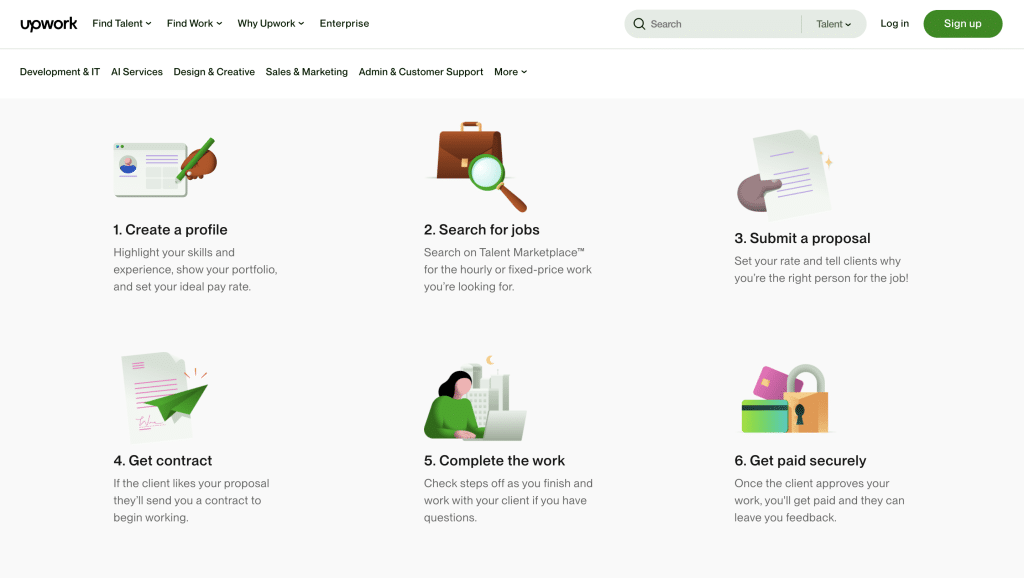
Fiverr
Fiverr is an online marketplace that connects freelancers with clients who are hiring for various services across a wide range of categories, from programming to music and audio.
Pros: It’s great for beginners because you can offer specific “gigs” starting at $5 (this makes it easy to get your first client). There’s less bidding and more direct client requests, making it perfect for newbies.
Cons: Rates can be very low in the beginning, and it takes time to build up enough reviews to charge higher prices. Fiverr takes a 20% commission on earnings, which can significantly reduce your take-home money, particularly on lower-priced gigs.

LinkedIn is a professional networking platform that you can use to showcase your skills and previous work, connect with potential clients, and discover job opportunities.
Pros: You can leverage your existing professional network; potential clients can see your experience and endorsements; Another great thing is that companies and clients post freelance and contract job listings directly on LinkedIn, so you can use it as a centralized place to search for gigs. You can do outreach directly via DMs with personalized pitches rather than have the clients find you through a platform.
Cons: LinkedIn is the #1 platform for networking, but it’s not primarily focused on freelancing. This means it can take you longer to find opportunities. It also requires proactive outreach and knowing how to sell yourself.
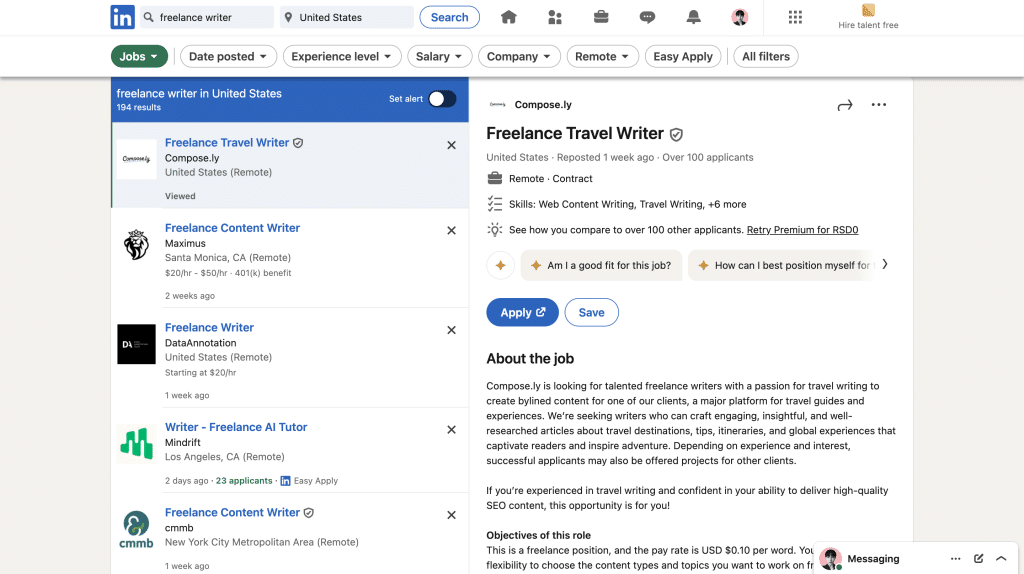
Freelancer.com
Freelancer.com is an online marketplace that connects freelancers with clients. It’s based on a bidding system and lets you bid on jobs across a wide range of categories.
Pros: There’s a global client range, a wide number of categories to choose from and you can set your own rates. The platform is community based, so you can share experiences and ask for tips from other members.
Cons: As with Upwork and Fiverr, there’s always the competition and service fees to take into account — they typically take 10-20% on earnings, which can reduce your overall income considerably, especially if it’s a small project.
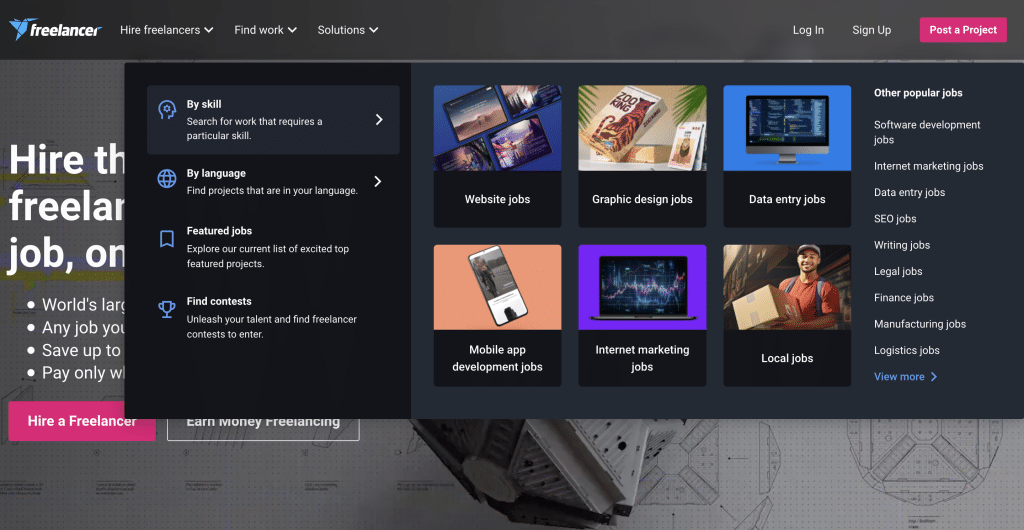
Toptal
Toptal is a freelancing platform that connects top freelancers in software development, design, finance, marketing, project and product management with clients looking for specialized talent.
Pros: Toptal is high-end and focuses on quality. It attracts reputable companies and freelancers get higher-paying projects. There’s often potential for long-term engagements, which can give you more stability and continuous income. As a Toptal freelancer, you get personalized matching — they pair you with projects that best align with your top skills and interests.
Cons: It’s hard to get accepted as a freelancer, especially if you have no experience. Since many of the projects are long-term, Toptal can require you to commit to specific project timelines and client requirements, which may reduce the flexibility that many freelancers want (it can often feel like a regular full-time role). My 2 cents — it’s best to build your portfolio through other platforms, then move to Toptal once you’ve accrued some experience.
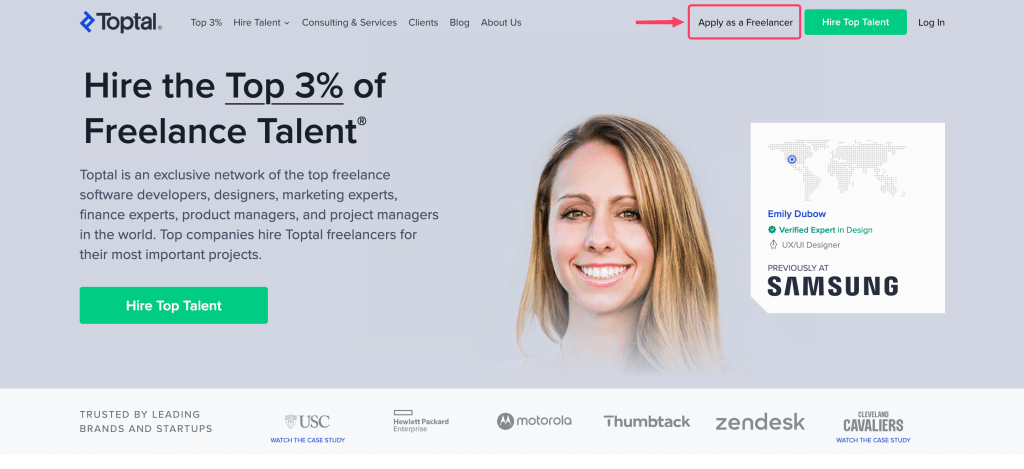
Freelance Writing Jobs
Freelance Writing Jobs is a platform that helps freelance writers find job opportunities across different niches and experience levels.
Pros: Specializes in writing jobs, so it’s great for English majors, journalism students, and aspiring writers. There’s a variety of work, including blogging, content writing, and academic writing.
Cons: Limited to writing-related gigs, so definitely not ideal if you’re looking for broader categories. Also, some gigs may be short-term with lower pay.

PeoplePerHour
PeoplePerHour is an online freelancing platform that connects businesses with freelancers across various categories, predominantly design, writing, marketing, and development.
Pros: Suitable for students with creative or technical skills (design, marketing, programming). You can set your hourly rate, and the platform allows you to bid for both long-term and short-term projects.
Cons: Highly competitive. It may take time to establish yourself and get steady work. The service fees vary from 3.5% to 20%, which can impact your final earnings.
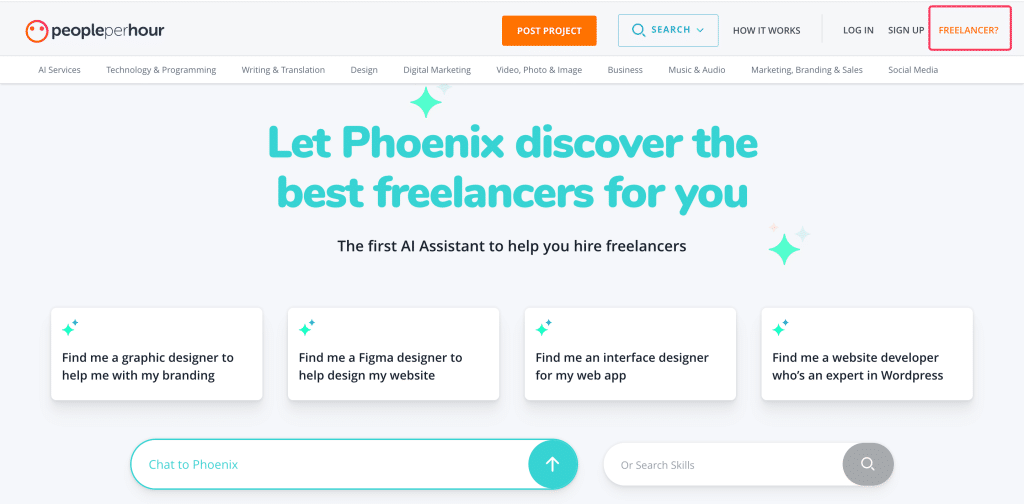
Guru
Guru is another popular freelance platform that you can use to find gigs across a wide range of categories like design, development, writing, translation, digital marketing, and legal.
Pros: You can create a profile showcasing your past work and get reviews that help build credibility. There are no bidding wars with other freelancers because Guru allows you to set fixed rates and lets clients view them upfront.
Cons: Guru takes a 9% commission on earnings unless you upgrade to a paid plan (tough for beginners). The platform itself is a bit outdated and there are fewer job listings compared to larger platforms.
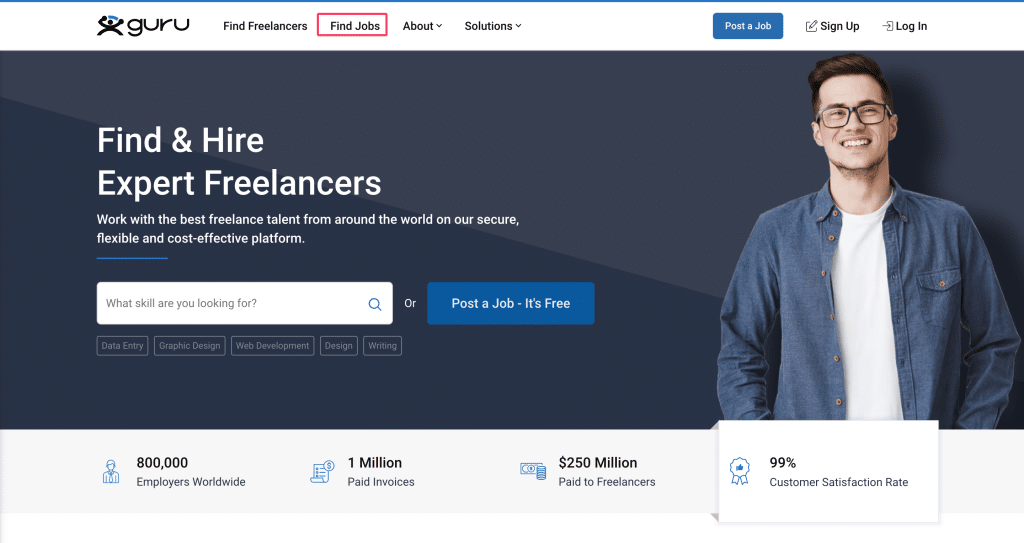
TaskRabbit
TaskRabbit is slightly different, as it focuses on local freelance tasks rather than remote, desk-based work. It connects freelancers with clients who need assistance with various tasks — from home repairs and cleaning to personal errands and administrative support.
Pros: Focuses on local freelance tasks like delivery, home repairs, furniture assembling, event planning, moves, making it ideal for students who want to freelance while managing their studies. You can choose tasks based on your availability and location, and the payment is near-instant after the task has been completed.
Cons: The tasks are typically more physical and opportunities depend on the city you’re in.
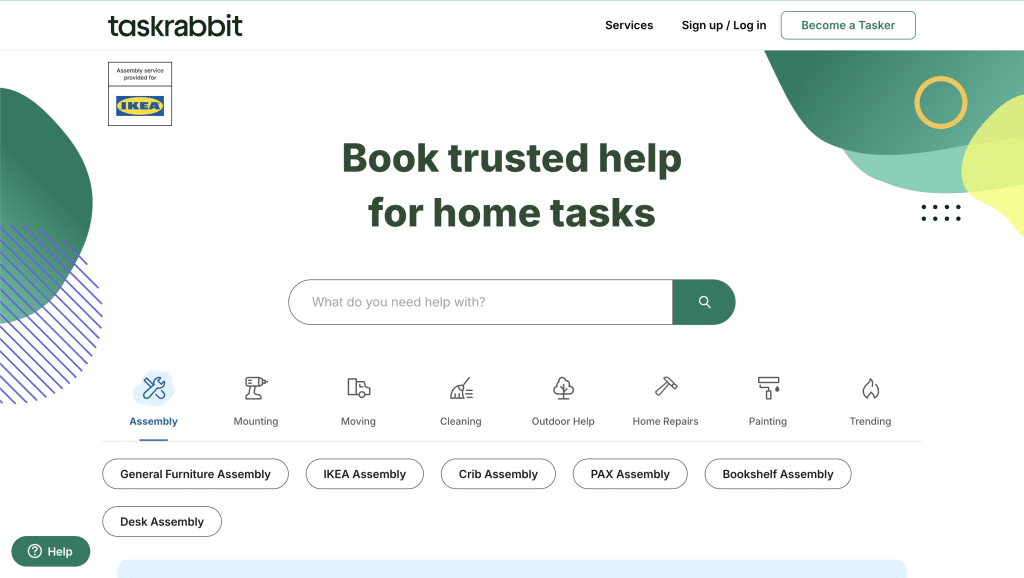
Behance
Behance is a niche platform that allows creative professionals to share their portfolios and find freelance work across fields, including graphic design, illustration, photography, video, advertising, and PR.
Pros: Ideal for creative students to showcase their portfolios. It’s a visually-driven platform where clients often scout for talent based on the work they see.
Cons: Behance is more of a portfolio platform, so you won’t see many job postings. You’ll need to put effort into self-promotion to get work.
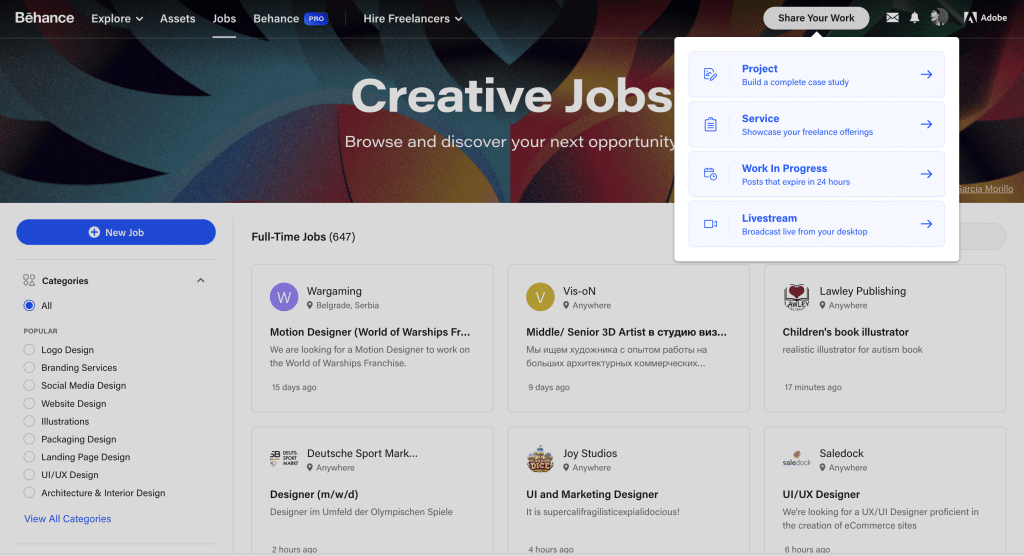
SolidGigs
Solid Gigs is a collection of freelance job listings from various sources. As a freelancer, you can use it as a centralized location to find high-quality gigs across multiple industries (including writing, design, programming, and marketing).
Pros: A curated list of high-quality freelance gigs, so you’re not competing with thousands of others and you save time on hunting gigs yourself. AI-based matching. Perfect for those short on time and looking for serious freelance work.
Cons: There’s a subscription fee to access the gigs (not ideal for students who aren’t ready to commit to paying for a service).
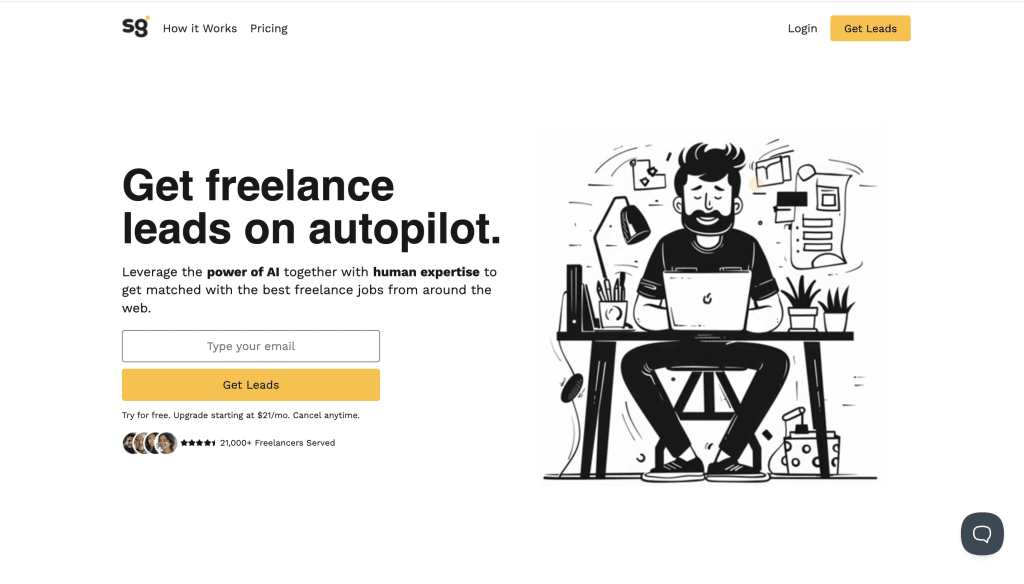
99designs
99designs is a specialized platform that connects freelance designers with clients and businesses who need design work (mostly logo and web design) through a contest-based model or direct hiring.
Pros: Great for students with a knack for design (graphic design, logos, branding). You can enter design contests, a good tactic for gaining experience and portfolio-building, or apply directly to client requests.
Cons: Design contests mean you don’t get paid for your work if you don’t win. There are entry fees for some contests. The platform also takes a 5-15% fee from earnings.
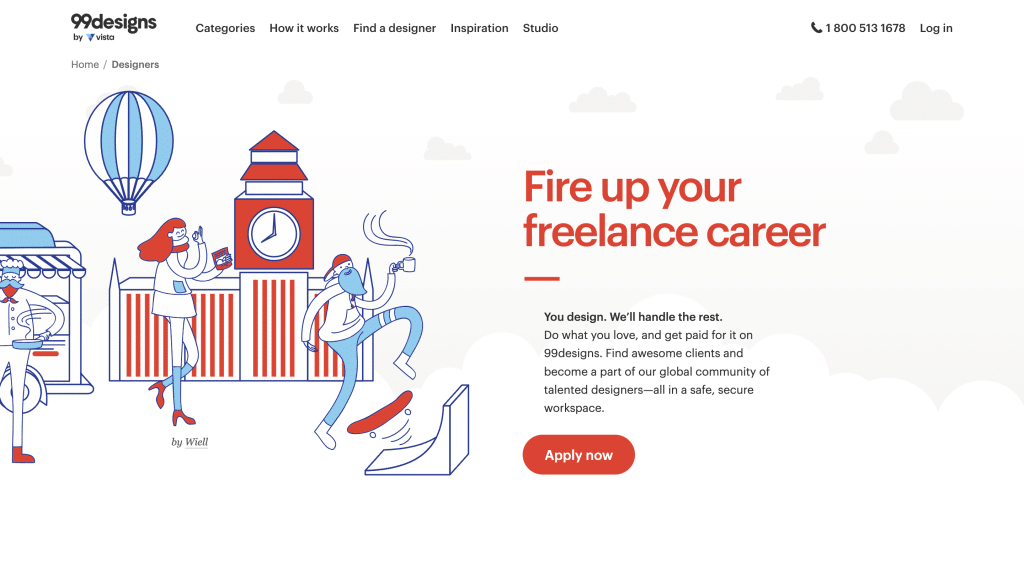
One rule to rule them all: It’s completely normal (and expected) for freelancers to have profiles on several of these platforms to increase their chances of getting hired. It will take you some time to get the hang of how each of them works, but you can set alerts and email notifications to help you track possible gigs more easily.
Networking strategies to find work
You don’t always need to look for work through online platforms. In fact, one of the most successful ways of building a freelance career and getting new clients is through networking.
Here’s what you can do to network successfully as an entry-level freelancer:
- Use your school contacts — Reach out to your professors, career services, or alumni network. Your university may have partnerships with businesses looking for freelance talent, or professors may have connections in the industry. Don’t hesitate to ask for introductions. And make sure to let your friends know what you do specifically and what kind of work you’re looking for.
- Join communities — From Facebook and LinkedIn groups to Reddit’s /r/freelance, there are many online spaces where you can link up with other freelancers, take part in discussions, and build connections that can land you gigs.
- Industry events, podcasts, and meetups — Let’s say you’re looking for UX/UI design gigs. Browse for virtual and local in-person events like conferences, lectures, or webinars. This is a great way to meet other people in the field, find mentors, and connect with potential clients. You can introduce yourself, talk about your skills, and offer your services on the spot. Prepare an elevator pitch to show your value quickly.
How to create pitches and proposals that stand out
I won’t lie — it’s not easy to secure new clients as an entry-level freelancer, but a well-crafted pitch can 10x your chances.
An elevator pitch is a quick, clear introduction to who you are, what you do, and why you’re the right fit for a job or project. It’s called an “elevator pitch” because it should be short enough to deliver in the time it takes for a quick elevator ride — around 30 seconds to a minute.
A proposal is a more detailed write-up where you explain how you would handle a specific project. It’s like a job application for freelancers, where you outline your understanding of the client’s needs, explain how you plan to solve their problem, and share your price and timeline.
Make sure to check out this in-depth guide with 9 Elevator Pitch Examples to Ensure You Stand Out.
As for proposals, here are some ground rules to follow and an example to use as inspiration:
- Don’t be generic and customize proposals for each client — Address the client by name and mention their company or project specifically.
- Hook them with value right away — Start by highlighting the main benefits of working with you, but don’t talk about yourself too much (avoid “I” statements). Instead, focus on how you will solve their problem (“What you’ll get” statements).
- Show relevant experience or expertise — Mention a few similar projects you did in the past or academic projects that relate to the job.
- Provide a clear CTA — Make sure it’s clear what you want them to do after they’ve read your proposal. For example, “If this sounds interesting, let’s set up a quick call to discuss the details”.
Pitch Example (LinkedIn Message)
Hello [Client Name],
Saw that you’re looking for help with your socials, and I’m confident I can help.
In my last project, I managed the Instagram and Facebook accounts for a student organization, which resulted in 30% follower growth in 3 months.
I used an organic approach and tapped into our community because the student association didn’t have any budget for these platforms. If you’re interested, I’d love to discuss your specific goals and see how we can work together to achieve them.
Hope to talk to you soon,
[Your Name]
Proposal Example
Subject: Proposal for Your Logo Design Project
Hello [Client Name],
I’m excited about the opportunity to work on your logo design project for [Client’s Business/Project Name].
I understand you’re looking for a modern and memorable logo that reflects your brand’s values. I have a strong academic background in graphic design and experience in creating logos for startups, so I’m confident my design will meet your expectations.
Here’s a quick outline of my proposed approach:
Research: I’ll start by analyzing your brand’s target audience and competitors to ensure the logo stands out in the market.
Concept Development: I will create three initial design concepts for your review, focusing on your desired aesthetics.
Revisions: Based on your feedback, I’ll refine the chosen design until it perfectly aligns with your vision.
Timeline and rates: I can deliver the final logo within two weeks, and my proposed budget for this project is [Your Rate]. I’m happy to discuss this further and adjust based on your needs.
Thank you for considering my proposal and do let me know if you have any questions or would like to discuss this project in more detail.
Best,
[Your Name]
[Your Contact Information]
[Your Portfolio Link]
Pricing Models and Tips on How to Charge for Your Services
When I first started as a freelancer, I was super confused about how to price my services. I realized I was a junior and shouldn’t charge as much as experienced freelancers on freelancing websites. On the other hand, it wasn’t like I lacked the knowledge or expertise to do the job well.
To help you find that balance, let’s first cover some typical pricing models for freelancers.
- Per hour — You charge based on the time spent on a project. It’s best for gigs that have unclear scopes and where the total amount of work is hard to predict, but not so good if you’re slow and the client asks you to justify the hours. It’s mostly used by web developers, assistants, consultants, interpreters, and designers.
- Per word — You charge based on the number of words you write. Very transparent, and works best for blog writers, copywriters, and translators. Not ideal if a project requires deep research, revisions or calls (which you can’t charge for).
- Per project — A flat fee for completing an entire project, no matter how long it takes. Ideal for website development, house repairs, voiceover, photographers, and designers. Good because it’s predictable and you don’t lose money if you’re efficient and finish sooner. The opposite is true too — in case the project stretches, you may end up working more than expected.
- Retainer — The client pays you a flat amount every month to be available for a specific number of hours or deliverables. This is the best model if you’re needed for longer projects or when you know they’ll be needing you to consistently produce the same amount of work each month (e.g. you’re a social media manager).
It’s difficult to predict which model will work best for you, but don’t panic if you don’t get it right the first time (or the first couple of times!). Over the years, I myself tested out different pricing models. I usually choose the one that’s most lucrative for me, but also makes sense for the client. As you get experience and establish connections with long-term clients, you can renegotiate all of this later.
In the meantime, check out this in-depth guide on money management for freelancers or take our little quiz:
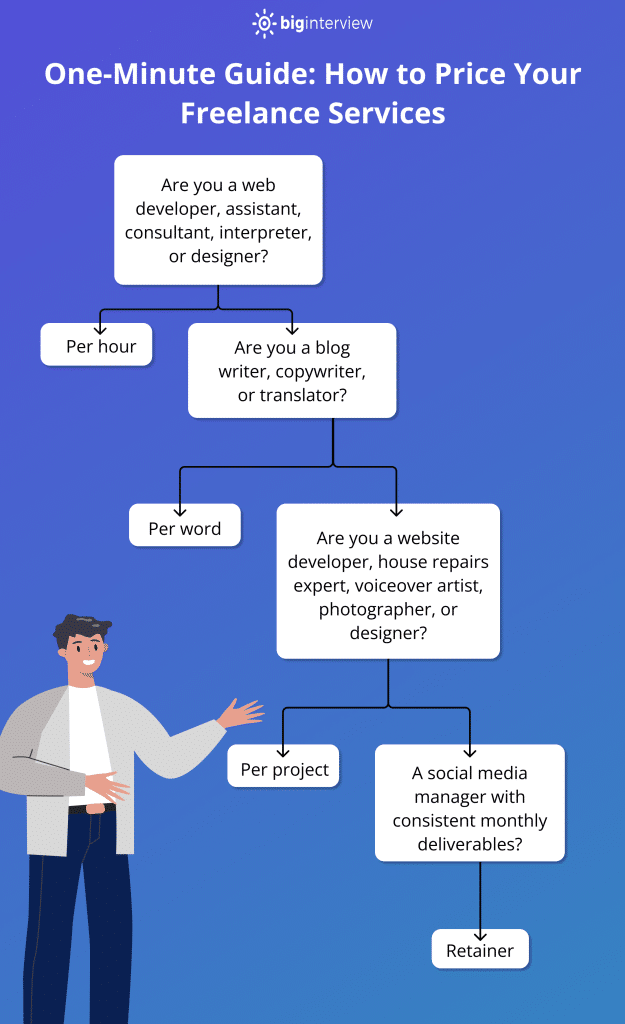
When it comes to pricing your services, these are my 5 favorite tips:
- Research industry standards — Look up average rates on freelance platforms, or ask experienced freelancers for advice.
- Consider your experience — Start with slightly lower rates, but don’t undervalue your skills. Raise your rates as you gain experience and build a portfolio.
- Don’t forget time and effort — Factor in the time you spend on research, communication, revisions, or meetings in your pricing.
- Don’t undercharge (although you’re a beginner) — It’s tempting to start low (“I just need some extra cash for that backpacking trip in Nicaragua”), but going much lower than the standard can make clients think your work quality is substandard too. Don’t sell yourself short!
- Be flexible — Remember my story about testing out different pricing models? Try them out with different clients or projects and see what works best.
Managing Time, Projects, and Clients
I can go on about this forever, but I think it all comes down to one ultimate tip — the sooner you learn this, the better.
As a freelancer, there will be times when you’ll have zero work lined up (dry spells are scary but normal), and also times when you’ll be juggling clients, projects, and deadlines (that’s even scarier and more stress-inducing).
Here’s how you can prevent burnout and panic:
Communicate openly and regularly
It’s important to have good communication with clients and set clear expectations. From the start, agree with the client about what you’ll deliver, when, and how often you’ll check in. Regular updates will help you keep the project on track and minimize misunderstandings.
Getting the feedback early on is great because the client may request changes, and you’ll have time to address them without delaying the entire project. It can be a weekly email summary or a quick call to touch base — the point is to build trust and avoid surprises when the project is almost over.
Let your clients know if you get sick or if there’s an emergency and you’ll be unavailable, especially if there’s a deadline you agreed on previously.
Stay organized with project management tools
If you work with multiple clients or projects, apps like Trello, ClickUp, Notion, and Asana allow you to create task lists, set deadlines, and track your progress visually. For example, you can break down large projects into smaller tasks, assign due dates and track your progress by moving the tasks from “To Do”, “In Progress” and “Done” easily.
All three apps are free if you have a single account. They’re also great for when you need to give clients transparent progress updates.
Set boundaries
Finally, it’s essential to set boundaries with clients to manage your workload and prevent burnout.
Be clear about your working hours and how quickly clients can expect a response from you.
This will help clients understand what’s realistic in terms of turnaround. If a client is expecting more than you can reasonably deliver, don’t hesitate to negotiate the timeline or adjust the project scope.
Legal and Financial Considerations
When freelancing, the less fun part is handling your legal and financial obligations properly, starting with contracts, managing payments, and paying your taxes.
Contracts 101
You need a well-written contract to protect you (and the client) by clearly outlining expectations, responsibilities, and key deliverables.
Key elements to include in your contract are:
- Scope of work — a detailed explanation of what you’re delivering,
- Payment terms — how much, the payment model, and what methods you accept, and
- Deadlines — specific due dates for each deliverable.
Make sure both you and the client agree on these points before starting any work.
How to manage payments (and clients who are late)
To manage payments, using invoicing tools like FreshBooks or Wave can make your life A LOT easier.
These apps allow you to create professional invoices, track when payments are due, and even send reminders for late payments.
If a client is late to pay you, you need to have a process in place. Nobody likes to chase after their clients to get paid, but it can be a normal part of running a freelance business. Start with a friendly email reminder, and, if that doesn’t work, you may need to include a late payment fee or escalate with a final notice.
Always have your payment terms, including late fees, clearly outlined in your contract to avoid issues.
Here’s a short template you can use to remind a client to pay you. If this doesn’t work or you need to send multiple reminders, ChatGPT can help to rephrase it.
Subject: [Your Name] Payment ReminderHi [Name],
I hope you’re doing well. I wanted to follow up regarding invoice [Number or Invoice Detail], which was due on [Insert Due Date]. As of today, the payment hasn’t been received.
If you’ve already processed the payment, please disregard this message. Otherwise, I would appreciate it if you could make the payment as soon as possible. For your convenience, here’s the invoice link again: [Insert Invoice Link].
Please reach out if there are any issues or questions regarding the payment. I’d be happy to assist.
Talk soon,
[Your Name]
Tax obligations
As a freelancer, you are responsible for paying your own taxes. You’ll need to report your earnings to the government and pay taxes based on your income. It’s a good idea to keep track of your income and expenses throughout the year so you’re not caught off guard during tax season.
Good news is that you’re also eligible for tax deductions for business-related expenses like office and software, which will reduce your total taxable income.
For accurate, up-to-date tax information specific to freelancers, it’s best to refer to official resources like the IRS Freelancers’ Tax Guide or your country’s tax authority.
This scared me the most when I was starting out, so I’m leaving a few useful links on how to file taxes, manage business expenses, and maximize deductions for U.S. freelancers to check out. I found this Freelancer’s Guide to Taxes to be the most helpful, but you may also need to look at:
- Self-employed individuals tax center | Internal Revenue Service
- Small Businesses Self-Employed | Internal Revenue Service
- Freelancers Union
- TurboTax® Tax Tips for Contractors, Consultants & Freelancers
- Freelance taxes: A beginner’s guide | QuickBooks
Scaling Your Freelance Career
If things keep going well, you may consider switching to full-time freelancing. A big move, but an exciting one. While the freedom is amazing, there are some extra steps to take to keep your cash flow steady and be able to handle more clients without feeling overwhelmed.
Here’s how you’ll know it’s time to step up:
- Steady income — Your income stream from freelancing is solid and consistent, and you have multiple clients (not just one or two).
- Established client base — You’ve got reliable, repeat clients and ongoing projects lined up.
- You saved some money — You have a financial cushion (typically 3–6 months of living expenses) to handle slow periods or unexpected situations without panicking.
- You’re disciplined and excited to go on — You’re organized, good at communicating with clients, and comfortable handling your taxes, contracts, and invoices.
Some things to keep in mind when transitioning to a full-time freelancer:
- Create a rainy day fund — Work for your future self too. Set aside money for retirement and healthcare since these won’t be provided by an employer.
- Get serious — Try to have a process for tracking income and expenses and paying taxes. You need to treat your freelance work like a formal business. Set up standard contracts, clear payment terms, and dedicated work hours.
- Play smart — I mentioned earlier how you need multiple clients (ideally from different industries). Shit can hit the fan unexpectedly (remember the pandemic?) and entire sectors can be affected. Relying on just one or two clients can be risky because losing them would have a big impact on your income.
- Expand your services — As you grow your freelance business, consider additional revenue streams like consulting, providing online courses, or selling digital products.
- Think about switching to an LLC or C Corp — In time, if you end up being a highly successful freelancer, you could level up and switch to a different business model. With both LLC or C Corp, you get more flexibility with how you are taxed, and shield your personal assets like a home or a car from being used to satisfy business debts.
- Set boundaries — Burnout is a common issue when you have a big client base because of busy schedules, conflicting priorities, and clashing deadlines. To avoid it, you need to set clear boundaries with clients, take regular breaks, eat well, and book time for exercise. And don’t forget to plan vacations or days off to fully recharge.
- Learn to say no — Speaking of boundaries, there’s nothing wrong with saying no to clients and potential clients. “No, I can’t meet that turnaround. What about the following week?” or “I don’t work on that type of project but I know someone who does”.
- Build your personal brand — When you’re freelancing, your personal brand is your business. So alongside being a boss, you have to do (self-)marketing and sales too. To stand out and attract better clients, you need to be visible, so make sure to be active on LinkedIn, attend events, share your work, update your website, and slowly build a recognizable brand.
- Collect positive feedback — There’s nothing like word of mouth and referrals. Always ask clients to review you after you complete a project, and aim to deliver an outstanding service. Recommendations will keep pouring in organically.
- Keep learning and growing — Freelancing is an ever-evolving space, and staying competitive requires upskilling and cross-skilling. There are platforms like Udemy, Coursera, or LinkedIn Learning where you can build new skills and refine your existing ones.
Summary of the Main Points
Here’s a TL;DR of key points to remember:
- As a freelancer, you’re not tied to a single employer. You are self-employed and you work with multiple clients on a project-by-project basis.
- It allows you to be your own boss, set your own hours, and pick the projects that excite you. On the flip side, you need to be self-disciplined and motivated to make it work.
- Disadvantages of freelancing include inconsistent income, lack of job security, and the fact that you need to handle all aspects of your business, from client acquisition to finances.
- Setting up your freelance business is fairly easy, but you need to stay in the loop on the legal aspects, and pay taxes regularly.
- How you’ll charge for your services typically depends on their type and industry.
